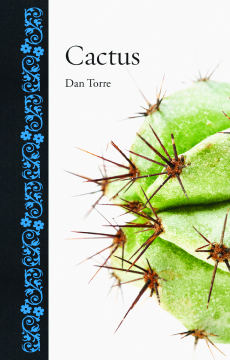
Additional Information
Book Details
Abstract
Cacti are full of contradictions. Although many are found in the driest and most barren environments on earth, some grow exclusively in the branches of the rainforest canopy. Many species bristle with ferocious-looking spines, while other varieties are perfectly smooth. And while they might strike us as the most austere plants on earth, nearly all of them exhibit remarkable floral displays—some even larger than the plant itself. In Cactus, Dan Torre explores these unique plants as they appear all around the world and throughout art, literature, and popular culture.
As Torre shows, cacti have played a prominent role in human history for thousands of years. Some species were revered by ancient civilizations, playing a part in their religious ceremonies; other varieties have been cultivated for their medicinal properties and even as a source of dye, as in the case of the prickly pear cactus and the cochineal insect, the source of red carmine used in everything from food to lipstick. Torre examines how cacti have figured in low-footprint gardens, as iconic features of the landscapes of Westerns, and as a delicious culinary ingredient, from nutritious Nopal pads to alluring Pitaya—or Dragon—fruits. Entertaining and informative, this book will appeal to any of us who have admired these hardy, efficient plants.
“A wide-ranging social and cultural history of cacti that champions a family of plants usually neglected by gardeners. . . . The book is learned and well-researched but always easy to read and full of fascinating anecdotes. . . . For anyone interested in the world of plants it will certainly provide an engaging insight into a fascinating group of plants. It might even stimulate a few gardeners to add a few cacti to their plot.”
— Gardens Illustrated
“Torre’s book also looks at cacti in art, literature, linguistic phrases, and popular culture. There are cactus fences, cactus medicines, and cactus societies. For a family of plants that has, at times, been widely loathed, it has managed to permeate every aspect of our lives.”
— The Age (Australia)
“Cacti’s diverse appearance and survival tactics have made them not just the focus of gardeners and photographers from desert to tropical regions, they have inspired sculptors, painters, filmmakers, and writers, and been used by cooks (think dragon fruit), and for their therapeutic qualities such as pain relief and antibacterial properties. The prickly pear was even revered by early civilizations such as the Aztecs. All this, just for a cactus? Look and learn with this entertaining book that uncovers the rich natural, cultural, and social history of a plant with attitude.”
— Reader’s Digest
“This fascinating title puts the horticultural specifics of the Cactaceae family in the spotlight, and explores their social and cultural impacts on society. . . . The worldwide popularity of cacti is well documented in these pages through interesting commentary and images.”
— Gardening Australia
“Gardeners spend much of the summer biding their time. A shelfful of handsome new books will tide them over. . . . [In Cactus,] celebrate cacti through art, literature, and culture.”
— Better Homes and Gardens
"This delightful series is accessible and worthwhile for general readers who are interested in plants, history, or art. Covering the history of human interaction with cacti and especially cactus-inspired art, this work is a fascinating ingress into all things cacti. . . . This work will appeal to a broad range of readers. . . . Highly recommended."
— Choice
Dan Torre is a lecturer in the School of Media and Communication at RMIT University in Melbourne.
Table of Contents
| Section Title | Page | Action | Price |
|---|---|---|---|
| Cover | Cover | ||
| Title Page | 3 | ||
| Imprint Page | 4 | ||
| Contents | 5 | ||
| Introduction | 7 | ||
| 1. Natural History of the Cactus | 15 | ||
| 2. Native Cacti, Alien Cacti | 46 | ||
| 3. Beautiful Cacti, Beastly Cacti | 71 | ||
| 4. Almost Human:The Anthropomorphic Cactus | 98 | ||
| 5. Eating Cacti | 128 | ||
| 6. Transforming the Cactus | 152 | ||
| 7. Cactus Collectors and Cactus Societies | 176 | ||
| Timeline | 198 | ||
| References | 203 | ||
| Further Reading | 211 | ||
| Associations and Websites | 213 | ||
| Acknowledgements | 217 | ||
| Photo Acknowledgements | 219 | ||
| Index | 221 |
